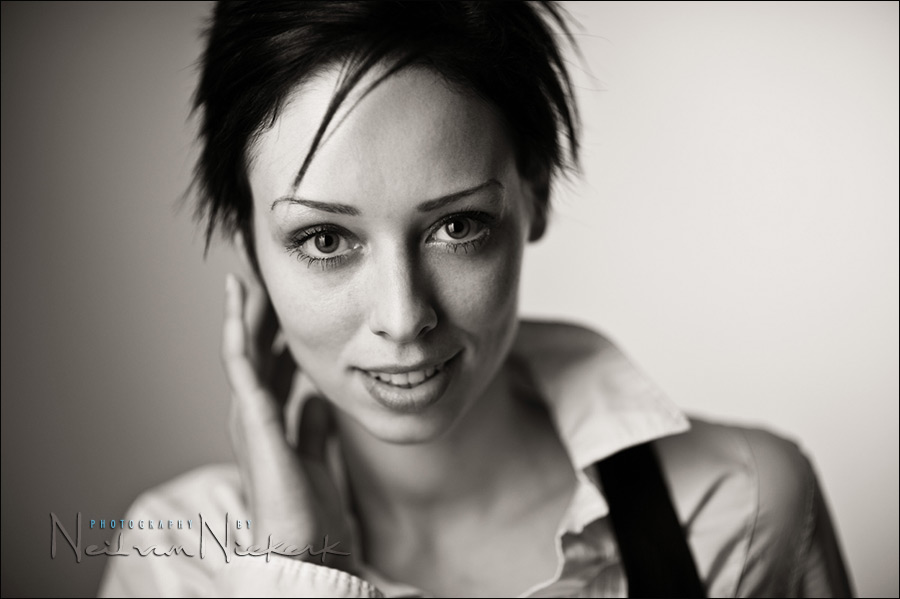
home studio portrait lighting setup in limited space
The photos in this article were shot with a fairly simple lighting setup in my dining room area. The main light to my left (model’s right) is the Westcott Bruce Dorn Strip Bank (18″x42″) (B&H). The flashgun was a Quantum T2, but a speedlight would’ve worked just as well. In this small a space, you don’t need huge amounts of light.
I used another Quantum T2 to light up the grey seamless background. I had the Quantum 12×12 softbox on this one, and feathered it to give me uneven light on the backdrop. I also had a snooted Nikon SB-800 as a hair light in most shots.
For some images, shot at f/1.4 the power was turned away down on the Q-flash – all the way down to 1/32 and 1/64 just to ensure that kiss of light.
Here’s a pull-back shot to show you just how unglamorous and cramped it looked. Yet the portraits looked great.
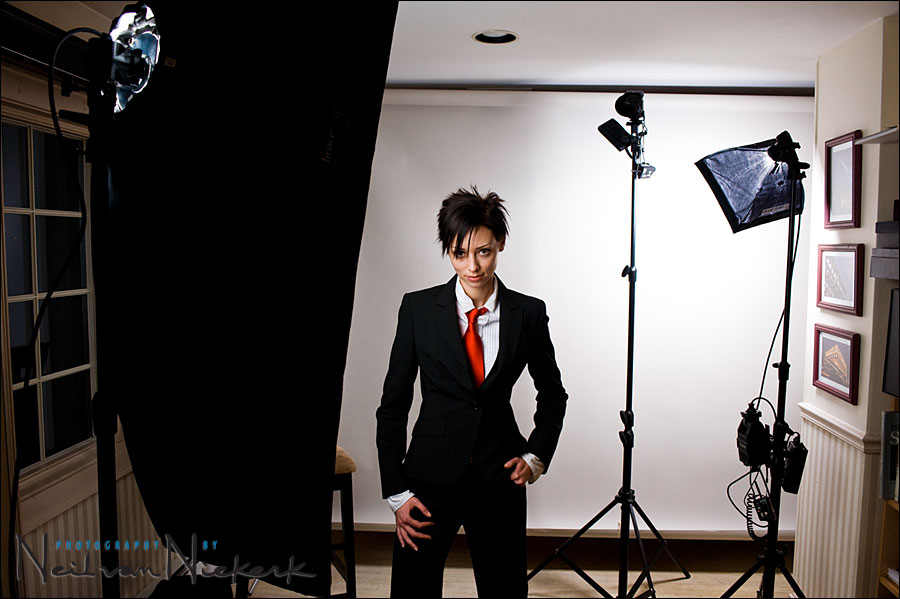
I used a variety of lenses for these portraits:

Nikon D700; Nikon 85mm f1.4 shot @ f1.4
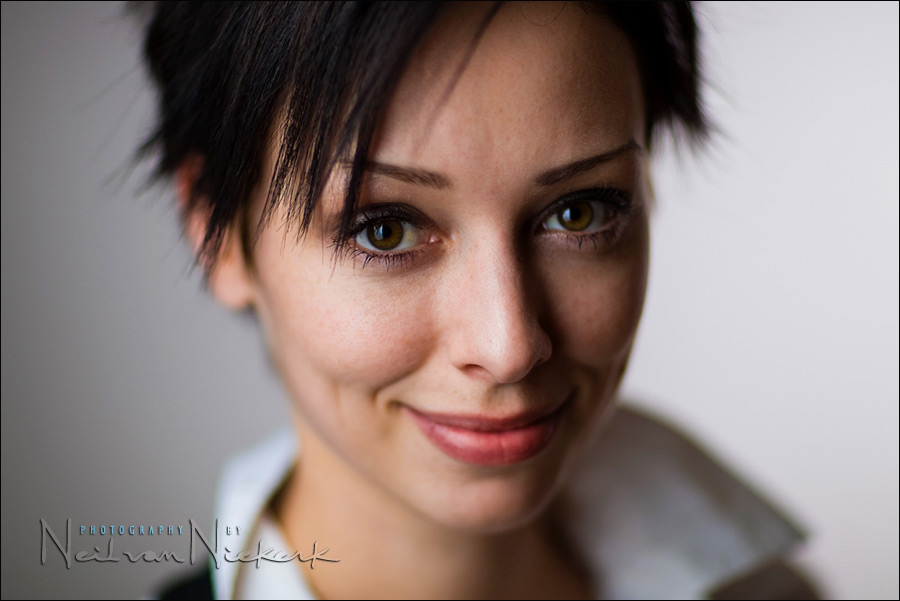
Canon 1D mk3; Canon 85mm f1.2 II shot at @ f1.4
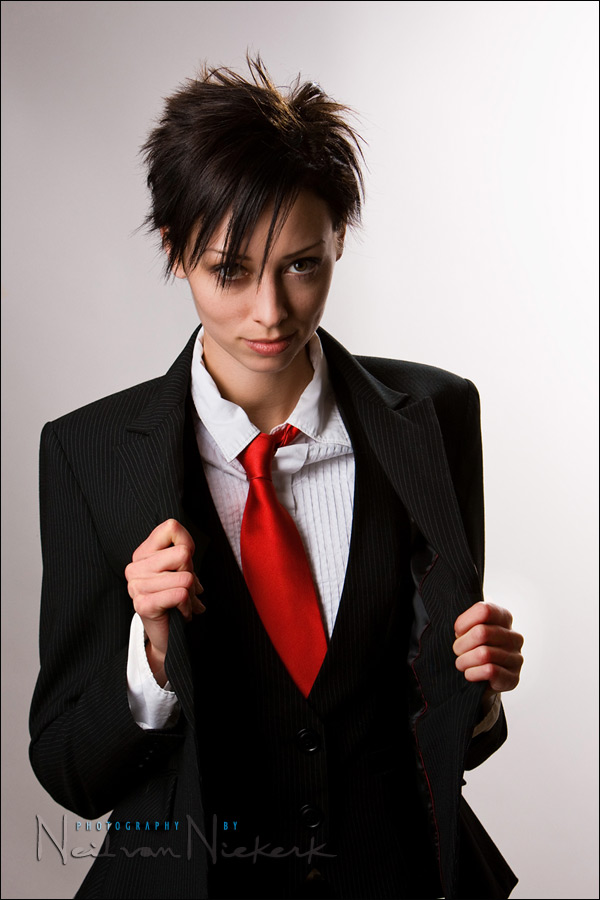
Canon 1D mk3; Canon 70-200mm f2.8 IS
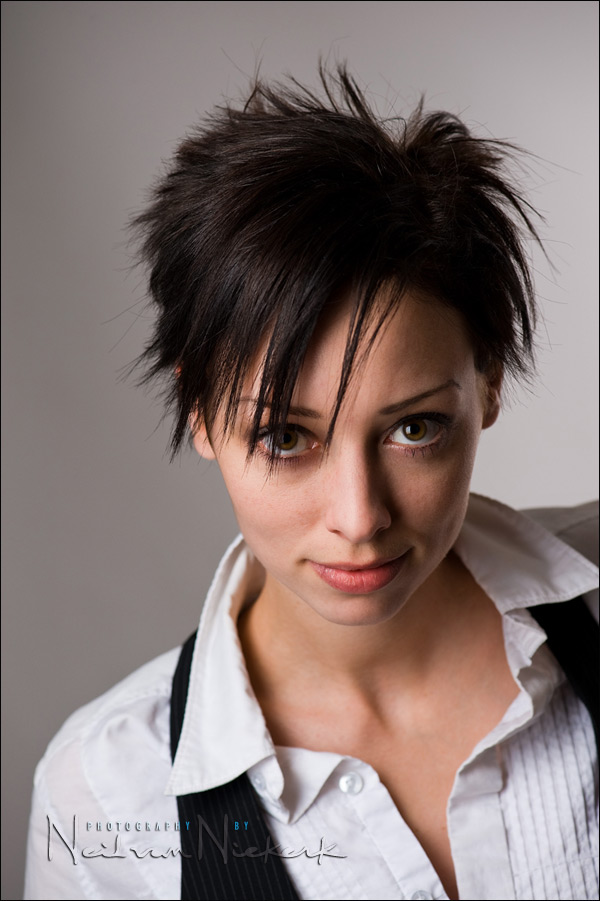
Nikon D700; Nikon 105mm f2.8 VR macro
Perfectly gorgeous work and subject.
The catch lights seem to indicate either window light or a soft box. How were these lit Neil?
Nice. Do you have any tips on ensuring enough DoF around the eyes when shooting wide open? Seems one must be very familiar with the lens/camera combination and know how much DoF is achieved at a given subject distance?
As for lighting, in addition to a big (guessing) soft box to camera left, it looks like there is also a separate light source behind and above Kaylex to camera right. Is the background lit separately?
hey neil,
was wondering, aside from showcasing this model…. were you testing out different lenses etc??? as i noticed each of the 4 shots was shot with a different lens????
thnx!
Brett …
The shoot actually started out with me wanting to test my new Profoto AcuteB 600R lighting kit (B&H), and the Profoto beauty dish (B&H) … but I was inadvertently supplied with the incorrect flash-head. So instead of just calling the shoot off, I played with some other lighting instead. : )
It was far too cold to venture outside, so I improvised a small studio set-up there in my dining room.
The use of different lenses (and cameras), was in part motivated by a conversation I had with a friend recently who is a Nikon shooter who was pining over the Canon 85mm f1.2 II (B&H) … which I thought was silly, since Nikon has the stellar Nikon 85mm f1.4D (B&H).
So the choice of lenses was just to show that there isn’t really any difference to be seen between the two lenses. Admittedly I used the Canon f1.2 optic at f1.4 because that is what my lights were set up for at that point … but I’d still go out on a limb here and say that it would be really tough to spot any difference between the results from either lens.
Similarly, I used 3 different cameras .. Nikon D3 (not posted here), Nikon D700, Canon 1D mk3 … and with slight adjustment in the raw post-production, there isn’t immediately much difference between how the files look when shooting this way.
Which brings me to a point I mentioned on one of the forums .. that in the everlasting Canon vs Nikon debate (and I certainly have my opinions on this), it ultimately doesn’t matter in the way that most photographers think it matters. What I strongly believe though, that what matters is that we should use the best that there is in any camera / lens make.
It’s a topic I touched on with an earlier posting here – equipment as inspiration. (This posting in turn was prompted by someone’s comments that the equipment didn’t matter at all.)
I hope this answers your question, although I think the answer was different than you expected. ; )
Thank you for this great web site where us old “film camera” relics can learn from a pro.
Your photography is outstanding. And this from a retired wedding photographer with 25 or thirty years experience. Your site was posted on https://www.photo.net last night, 12/24/08.
A very Merry Christmas, and a Happy New Year.
Richard Beisigl
You just keep making it look so easy! Oh, and that 1.4, that would be a sweet ‘bride’ lens… Thanks for keeping us all inspired!
A little off topic, but MERRY CHRISTMAS !!!
Thanks for all the hard work you do in putting together these tips and post and images for us all to learn from.
Hope Santa brought you something in an F 2.0 flavor :)
Merry Christmas Niel !!! The pictures are awesome. I also have trouble choosing Nikon or Canon for a long time and your advise above make me realize the most important is the person who take photos not the gears. Thanks!
Happy holidays Neil!
Thanks for showing the equipment setup you used for this shoot. I’m glad to continue to see that basic studio lighting setups can be bought for less than a few thousand dollars. My wife and I already bought a white backdrop and stand from B&H, and she took a portrait photo of my sister and me for a present to my parents. I am impressed how a little equipment goes a long way in the creative aspects of photography. When we had the photo printed at the local photo development store, the store was asking if this was professionally done (for photo release reasons). It’s nice to be able to reach a point where our photography starts to take a “professional” look to them.
I’ve got a question which you might be the right person to ask from: What is the difference between the quality of the out of focus made by large apertures and made by large focal lengths? I mean, for example, could you make the second photo from top by a larger focal length and f/5.6 or f/8?
By the way, thanks for the great tips. I always follow your posts.
Neil,
I got the feeling when looking at the FM buy/sell forum that you were in the process of getting rid of all your Canon equipment and going Nikon. Is that true?
Neil,
Could you elaborate on “feathering” the softbox to get uneven lighting on the backdrop. I’m not familiar with this but I like the look of it.
Thanks so much!
Brian
Amazingly informative site, Neil. I have learned more here than anywhere else. Thank you.
I shoot the Nikon 85/1.4 on a D200. I find the DOF almost too razor thin when used wide open and very challenging to get enough in focus. Your shots above look amazing wide open. Do you find it easier to shoot wide open on the full-frame D700 because the DOF is not quite as narrow?
P.S. Come to Minneapolis with your workshop.
thanks Neil
very interesting and enlightening
fantastic !
Have you ever compared the 85mm f1.8 vs the f1.4 side by side? How much difference is there in Dof and Bokeh quality at say f1.8 on both?
Very interesting article! I have a question how you edit the nikon d700 file? I mean if it was a lightroom, what camera profile do you use? Thank you!
This is rock solid photography. I would request you to do one entire video / blog post on how to use this 85 mm 1.4 lens. I have noticed many people are facing difficulty in using this lens and later on they just stop using it